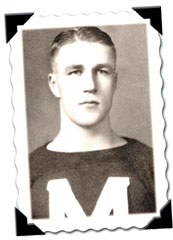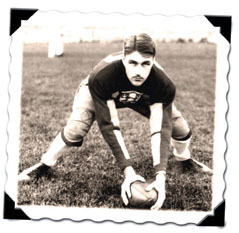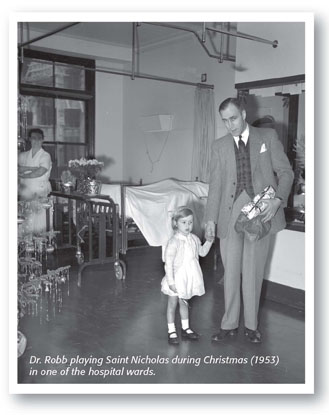 The
team skills he learned in the Molson stadium stood him in good stead
The
team skills he learned in the Molson stadium stood him in good stead
later on, perhaps contributing to his outstanding abilities as a captain of
the rehabilitation group he created at the Montreal Children’s Hospital and
as a leader of neurology at McGill. After interning at the Montreal General
Hospital and the Verdun Protestant, he joined the Royal Canadian Navy
serving overseas and then at a base in Montreal. In response to Dr. Penfield’s
urgent request he was remanded to the Montreal Neurological Hospital. This
experience sealed his fate propelling him into a career in neurology and
prompting him to return there at the end of the War.
 An
extended tour of American paediatric neurological centres took him to Johns
Hopkins where he spent some time with Frank Ford, whose clinical skills he
greatly admired, and to Boston where he worked with Richmond Paine and Randolph
Byers. Upon his return to Montreal heset to work at the Montreal Children’s
Hospital and the Montreal Neurological Institute. At the Children’s he succeeded
Francis McNaughton, who was to become McGill’s first Professor of
Neurology. He was for generations of trainees from all over the world a role
model of rectitude and fairness. As well, he was a magnificent teacher, always
nurturing independent thought and supporting initiative.
An
extended tour of American paediatric neurological centres took him to Johns
Hopkins where he spent some time with Frank Ford, whose clinical skills he
greatly admired, and to Boston where he worked with Richmond Paine and Randolph
Byers. Upon his return to Montreal heset to work at the Montreal Children’s
Hospital and the Montreal Neurological Institute. At the Children’s he succeeded
Francis McNaughton, who was to become McGill’s first Professor of
Neurology. He was for generations of trainees from all over the world a role
model of rectitude and fairness. As well, he was a magnificent teacher, always
nurturing independent thought and supporting initiative.
He was punctual, decisive, and his clinical judgement was phenomenal. Like many
great paediatric neurologists, he obtained most of his information by watching
children at play and interacting with their games. He was extraordinarily fond
of children and they responded in kind, undaunted by his imposing stern exterior
known to intimidate cocky residents and obstreperous sailors alike.
Cerebral palsy was a common problem
during the years Robb was in practice. Accordingly, he developed a cerebral
palsy conference staffed by a formidable team of occupational therapists,
physiotherapists, speech therapists, orthopedic surgeons, social workers,
psychiatrists, special education teachers and psychologists. Robb was a magnet.
He attracted the fi nest members of these professions to his group and they
formed a dynamic, loyal team around their captain. The cerebral palsy conference
at the Montreal Children’s Hospital served for many years as a model for centres
across Canada.